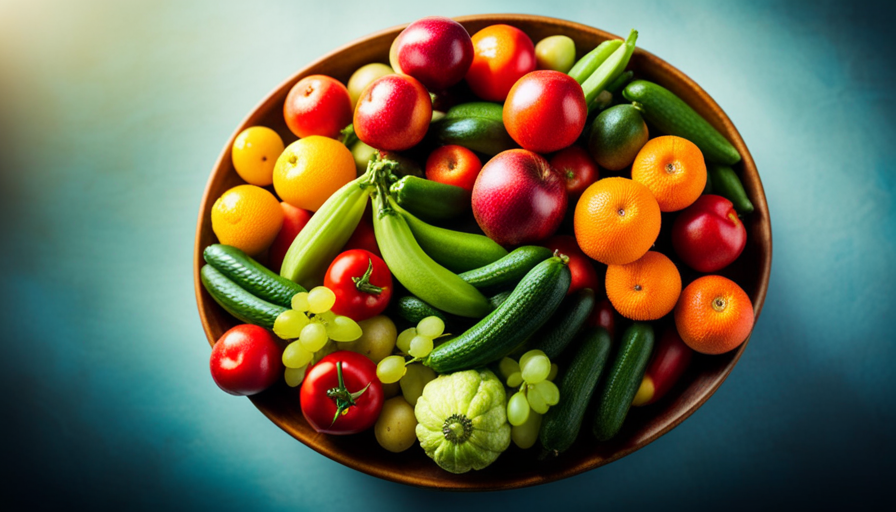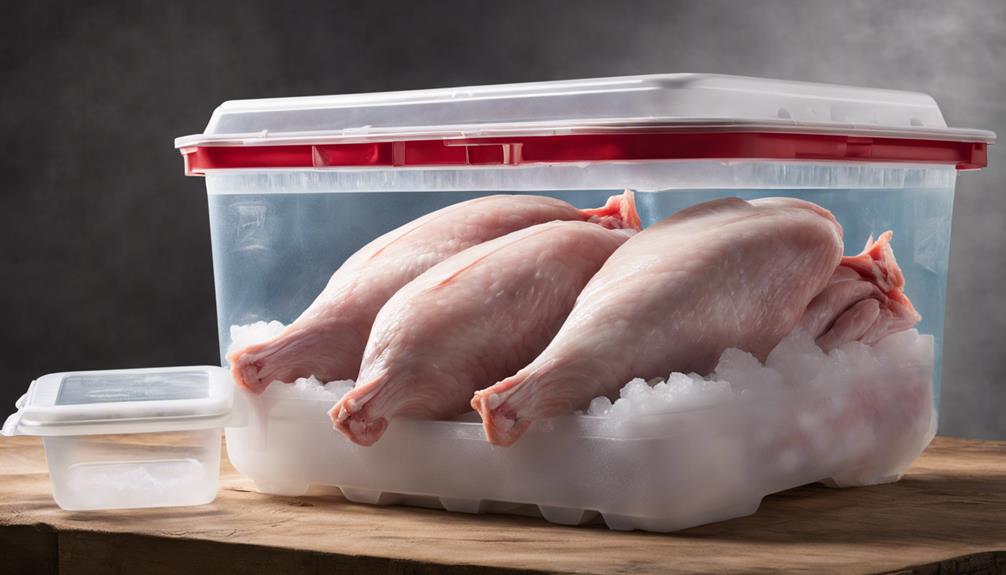I happened to find myself recently pondering whether or not I should treat myself to a tasty dish made with raw eggs. As I weighed the idea of the creamy texture and decadent taste, I couldn’t help but wonder – what are the risks of getting food poisoning from eating raw eggs? This is a common concern that many people have, and for good reason.
Raw eggs have long been associated with the risk of Salmonella contamination, a bacteria notorious for causing food poisoning. But just how likely is it to fall victim to this unpleasant illness?
In this article, we will delve into the world of raw eggs and explore the risks they pose to our health. We will uncover the presence of Salmonella in raw eggs, discuss the symptoms of food poisoning, identify high-risk groups, and provide precautions to reduce the risk of contamination.
So, if you’ve ever wondered about the safety of raw eggs, join me on this journey as we uncover the truth and make informed choices for our health and safety.
Key Takeaways
- Raw eggs can contain harmful bacteria, including salmonella.
- Cooking eggs thoroughly kills bacteria and makes them safe to consume.
- Good hygiene practices can help prevent salmonella infection.
- Choosing pasteurized eggs reduces the risk of food poisoning from consuming raw or undercooked eggs.
Understanding the Risks of Consuming Raw Eggs
You might want to think twice before indulging in that raw egg, as the risks of food poisoning are lurking just beneath its seemingly innocent shell.
While consuming raw eggs has gained popularity in recent years, it’s essential to understand the risks associated with this practice. Despite the prevalence of raw egg consumption in certain cultures and diets, it’s important to note that raw eggs can contain harmful bacteria, including salmonella.
Raw eggs offer several nutritional benefits, such as being high in protein and containing essential vitamins and minerals. However, the potential health risks outweigh these advantages. Raw eggs have been linked to outbreaks of salmonella poisoning, a bacterial infection causing symptoms like diarrhea, fever, and abdominal cramps. Salmonella can be present both on the shell and inside the egg, contaminating the egg during the laying process.
To reduce the risk of food poisoning, it’s crucial to handle and cook eggs properly. Cooking eggs thoroughly kills any bacteria, including salmonella, making them safe for consumption.
By transitioning to the subsequent section about the presence of salmonella in raw eggs, we can further explore the dangers of consuming raw eggs and how to protect oneself from foodborne illnesses.
The Presence of Salmonella in Raw Eggs
The likelihood of contracting a bacterial infection from consuming a raw egg, such as salmonella, is as high as a tightrope walker’s risk of falling without a safety net. Salmonella is a common bacteria found in raw eggs, and it can cause food poisoning if ingested.
To prevent salmonella infection, it’s crucial to take certain egg safety measures. One of the most effective ways to prevent salmonella is by cooking eggs thoroughly. Heat destroys the bacteria, making the eggs safe to consume. It’s recommended to cook eggs until both the yolk and white are firm. Avoid consuming raw or undercooked eggs in dishes like homemade Caesar salad dressing, mayonnaise, or raw cookie dough.
Additionally, practicing good hygiene is essential in preventing salmonella. Wash your hands thoroughly with soap and water before and after handling raw eggs. Use separate utensils and cutting boards for raw eggs to avoid cross-contamination. Refrigerate eggs promptly and keep them at a temperature below 40°F (4°C) to slow down bacterial growth.
By following these salmonella prevention and egg safety measures, you can significantly reduce the risk of contracting a bacterial infection from raw eggs.
In the next section, we’ll explore the symptoms of salmonella food poisoning.
Symptoms of Salmonella Food Poisoning
One can experience a range of unpleasant symptoms after consuming salmonella-contaminated eggs. Symptoms of salmonella food poisoning usually appear within 12 to 72 hours after ingestion. These symptoms include diarrhea, abdominal cramps, and fever. In some cases, individuals may also experience nausea, vomiting, and headache. The severity of the symptoms can vary from mild to severe, depending on the individual’s immune system and the amount of bacteria consumed.
To prevent salmonella infection from raw eggs, it’s important to follow proper food safety measures. This includes storing eggs in the refrigerator at or below 40°F (4°C), washing hands thoroughly before and after handling eggs, and avoiding cross-contamination with other foods. Cooking eggs thoroughly is also crucial to kill any potential bacteria. The internal temperature of the cooked egg should reach at least 160°F (71°C) to ensure safety.
Consuming salmonella-contaminated raw eggs can lead to several uncomfortable symptoms, including diarrhea, abdominal cramps, and fever. To prevent such infections, it’s essential to handle and cook eggs properly. Taking these prevention measures can significantly reduce the risk of salmonella food poisoning.
Moving forward, it’s important to understand the high-risk groups for salmonella infection.
High-Risk Groups for Salmonella Infection
Feeling under the weather? Watch out for who you share your favorite homemade mayonnaise with, as certain groups, like the elderly and those with weakened immune systems, are at higher risk for salmonella infection. It’s important to understand that while eggs are a delicious and versatile ingredient, they can also carry harmful bacteria like salmonella. To protect ourselves and our loved ones, we need to follow proper food safety guidelines.
One effective way to prevent salmonella infection is by cooking eggs thoroughly. This ensures that any bacteria present in the raw egg are killed. Additionally, it’s important to store eggs properly, keeping them refrigerated at a temperature of 40°F or below. This helps to inhibit the growth of bacteria.
To better understand the high-risk groups for salmonella infection, take a look at the table below:
| High-Risk Groups | Examples |
|---|---|
| Elderly individuals | Grandparents, senior citizens |
| Immunocompromised individuals | People with HIV/AIDS, cancer patients |
| Infants and young children | Babies, toddlers |
By following salmonella prevention measures and food safety guidelines, we can reduce the risk of food poisoning. Now, let’s explore some precautions we can take to further minimize this risk.
Precautions to Reduce the Risk of Food Poisoning
When it comes to reducing the risk of food poisoning from eggs, there are several precautions that I always take.
First and foremost, I make sure to buy and store eggs properly, keeping them refrigerated at all times.
Additionally, I always cook eggs thoroughly to kill any potential bacteria, and I take extra care to avoid cross-contamination by washing my hands and utensils thoroughly after handling raw eggs.
Lastly, I opt for pasteurized eggs whenever possible, as they undergo a heat treatment that eliminates harmful bacteria.
These precautions have helped me feel confident in enjoying eggs without worrying about the risk of food poisoning.
Buy and Store Eggs Properly
Properly buying and storing eggs is the key to ensuring a safe and delicious meal without the risk of food poisoning from raw eggs. When buying eggs, it’s important to check the expiration date on the carton and choose eggs that aren’t cracked or dirty. Additionally, always buy eggs from a reputable source to minimize the risk of contamination.
Once purchased, eggs should be stored in the refrigerator at a temperature of 40°F or below. It’s best to keep them in their original carton to protect them from absorbing odors and flavors from other foods. Remember to store eggs in the main part of the refrigerator, not the door, as the temperature fluctuates more there.
By following these buying tips and proper storage techniques, you can reduce the chances of food poisoning from raw eggs.
Now, let’s move on to the next section about cooking eggs thoroughly.
Cook Eggs Thoroughly
To ensure a safe and enjoyable meal, it’s crucial to cook eggs thoroughly until they’re perfectly done. Undercooked eggs can pose serious health risks as they may contain harmful bacteria like Salmonella. Proper cooking destroys these bacteria, minimizing the chance of food poisoning. To ensure your eggs are cooked thoroughly, follow these guidelines:
| Cooking Method | Minimum Internal Temperature |
|---|---|
| Hard-boiled | 160°F (71°C) |
| Fried or poached | 144°F (62°C) |
| Scrambled | 160°F (71°C) |
| Omelette | 160°F (71°C) |
| Baked | 160°F (71°C) |
By cooking eggs to the recommended internal temperatures, you can eliminate the risk of consuming undercooked eggs and the potential health hazards associated with them. Moving on to the next section about avoiding cross-contamination, it’s important to take additional precautions to ensure a safe and healthy meal.
Avoid Cross-Contamination
Make sure you prevent cross-contamination by keeping your cooking tools and surfaces clean and separate from raw eggs. This is essential in avoiding the risk of food poisoning from raw eggs. Always wash your hands thoroughly before and after handling raw eggs to prevent the spread of bacteria. Use separate cutting boards and utensils for raw eggs and other foods to avoid cross-contamination.
Clean the surfaces and utensils with hot, soapy water after each use. Proper handling of raw eggs is crucial to minimize the chances of foodborne illnesses. By taking these precautions, you can significantly reduce the risk of getting sick from raw eggs.
Transitioning into the next section, it’s also important to choose pasteurized eggs to further ensure food safety.
Choose Pasteurized Eggs
When choosing eggs, remember to opt for pasteurized ones to ensure your safety. Pasteurization is a process that involves heating the eggs to destroy any harmful bacteria, such as Salmonella, that may be present. This significantly reduces the risk of food poisoning from consuming raw or undercooked eggs.
Here are three key benefits of choosing pasteurized eggs:
-
Safety: Pasteurization kills bacteria that can cause foodborne illnesses, making pasteurized eggs a safer choice for recipes that call for raw or undercooked eggs.
-
Nutritional Value: Pasteurized eggs retain the same nutritional value as raw eggs, including high-quality protein, vitamins, and minerals.
-
Versatility: Pasteurized eggs can be used in a variety of recipes, from homemade mayonnaise to meringues, without the worry of foodborne illness.
By choosing pasteurized eggs, you can confidently enjoy recipes that call for raw eggs without compromising your health.
Now, let’s explore some alternatives to raw eggs in recipes.
Alternatives to Raw Eggs in Recipes
If you want to avoid the risk of food poisoning, you should consider using alternatives to raw eggs in your recipes. There are several egg substitutes available that can be used in vegan baking or for those who prefer not to consume raw eggs. These substitutes can provide the same texture and binding properties as raw eggs, without the risk of foodborne illnesses.
One popular alternative is applesauce, which can be used as a replacement for eggs in recipes such as cakes, muffins, and cookies. It adds moisture and helps to bind the ingredients together, resulting in a delicious and moist final product. Another option is mashed bananas, which can be used in recipes like pancakes and breads. Bananas not only add moisture but also lend a subtle sweetness to the dish.
For a more neutral flavor, you can use silken tofu as an egg substitute. It works well in recipes like quiches and custards, providing a creamy texture and richness. Lastly, there are commercially available egg substitutes that are made specifically for baking. These products are often made from a combination of vegetable oils, starches, and leavening agents.
By using these alternatives, you can enjoy your favorite recipes without the worry of food poisoning. Now, let’s explore safe ways to enjoy raw-egg-based dishes.
Safe Ways to Enjoy Raw-egg-based Dishes
Indulge in the delightful dance of flavors that raw-egg-based dishes offer, while keeping in mind the importance of ensuring your ingredients are fresh and handled with care. Raw egg safety is crucial when it comes to enjoying dishes like Caesar salad dressing or homemade mayonnaise.
Here are three essential tips to savor raw-egg-based dishes while minimizing the risk of food poisoning:
-
Choose Fresh Eggs: Always opt for eggs with intact shells and a recent expiration date. Fresh eggs have a lower risk of containing harmful bacteria.
-
Use Pasteurized Eggs: Consider using pasteurized eggs, which have been heated to kill any potential pathogens. These eggs are a safe alternative for those concerned about consuming raw eggs.
-
Proper Storage and Handling: Store eggs in the refrigerator at a temperature below 40°F (4°C) and separate them from other foods. When cracking eggs, do it in a separate bowl to avoid contaminating other ingredients.
Raw eggs offer health benefits such as being a rich source of protein, vitamins, and minerals. However, it’s important to balance these benefits with proper food safety practices.
Transitioning into the next section, it’s crucial to educate ourselves about the importance of food safety to prevent any potential risks.
The Importance of Food Safety Education
Now that we know the safe ways to enjoy raw-egg-based dishes, let’s take a moment to understand the importance of food safety education.
Foodborne illnesses can have a significant impact on our health and well-being, and proper food handling techniques play a crucial role in preventing such illnesses.
Food safety education is essential because it helps us understand the risks associated with improper handling and consumption of raw eggs. By learning about the potential dangers, we can take necessary precautions to minimize the chances of food poisoning. This education equips us with the knowledge of how to properly handle, store, and prepare raw eggs, ensuring that we enjoy them without putting our health at risk.
It is important to recognize that foodborne illnesses can have severe consequences, ranging from mild discomfort to hospitalization or even death. By understanding the impact of these illnesses, we become more motivated to prioritize food safety in our daily lives.
In the next section, we will explore the regulations and guidelines for egg safety, which further emphasize the importance of proper handling.
Regulations and Guidelines for Egg Safety
Egg safety regulations and guidelines ensure that proper handling and preparation techniques are followed, creating a safe environment for enjoying delicious egg-based dishes. These regulations are put in place to protect consumers from the risk of foodborne illnesses, such as salmonella, which can be caused by consuming raw or undercooked eggs.
Compliance with these regulations is essential for anyone involved in the production, distribution, and preparation of eggs. This includes egg producers, food establishments, and even home cooks. By following these guidelines, the risk of contamination and the spread of bacteria can be minimized.
One important aspect of egg safety regulations is proper egg handling practices. This includes storing eggs at a safe temperature, which is below 45°F, and ensuring they are not cracked or dirty. Additionally, eggs should be cooked thoroughly to an internal temperature of 160°F to kill any potential bacteria.
Making informed choices for your health and safety when it comes to egg consumption is crucial. By understanding and adhering to egg safety regulations and guidelines, you can protect yourself and your loved ones from the risk of foodborne illnesses. So go ahead and enjoy your favorite egg dishes, knowing that you have taken the necessary precautions to ensure their safety.
Conclusion: Making Informed Choices for Your Health and Safety
In a world where regulations and guidelines may seem like a buzzkill, it’s refreshing to know that you can still make informed choices for your health and safety and enjoy your favorite egg dishes.
When it comes to the risk of food poisoning from raw eggs, there are a few precautions you can take to minimize your chances.
First and foremost, it’s important to buy eggs from a reputable source. Look for eggs that are properly refrigerated and haven’t passed their expiration date. Additionally, consider purchasing eggs that’ve been pasteurized, as this process kills harmful bacteria.
When handling raw eggs, proper hygiene is key. Always wash your hands thoroughly before and after handling eggs, and make sure to clean any utensils or surfaces that come into contact with raw eggs. It’s also crucial to cook eggs thoroughly to kill any potential bacteria. Avoid dishes that use raw or undercooked eggs, such as homemade Caesar dressing or eggnog.
While the risk of food poisoning from raw eggs exists, it can be minimized by making informed choices and following health and safety precautions. By buying eggs from reputable sources, practicing proper hygiene, and cooking eggs thoroughly, you can enjoy your favorite egg dishes without compromising your well-being.
Frequently Asked Questions
Can I still eat raw cookie dough if I use pasteurized eggs?
Yes, you can still eat raw cookie dough if you use pasteurized eggs. Incorporating pasteurized eggs into recipes significantly reduces the risk of foodborne illnesses like salmonella. However, it’s important to note that eating raw eggs in other recipes still carries some risk. If you’re looking for alternatives to raw eggs in baking, you can try using substitutes like applesauce or mashed bananas. These alternatives provide moisture and binding properties similar to eggs in baked goods.
Are there any health benefits to consuming raw eggs?
Consuming raw eggs can carry health risks, despite claims of nutritional value. For instance, in a case study, a person contracted Salmonella after consuming raw eggs in a homemade Caesar dressing. While raw eggs are a source of protein and contain essential vitamins, it’s crucial to consider the potential health risks. Cooking eggs thoroughly can eliminate the risk of food poisoning, making it a safer option for consumption.
How can I tell if an egg is contaminated with salmonella?
When it comes to egg safety, it’s important to be aware of the signs of salmonella contamination. Salmonella is a bacteria that can be found in raw eggs. Symptoms of salmonella poisoning include diarrhea, abdominal pain, fever, and vomiting. To determine if an egg is contaminated, you can’t rely on appearance alone. It’s crucial to cook eggs thoroughly to kill any potential bacteria.
Can I still eat eggs with runny yolks?
Sure, I can still eat eggs with runny yolks as long as I take the necessary precautions. When consuming raw eggs, there are risks of food poisoning, particularly from salmonella.
To safely consume runny yolks, I make sure to use fresh, properly stored eggs from a reliable source. Additionally, I avoid eating raw eggs if I have a weakened immune system or if I’m pregnant, as the risks are higher.
Can I get sick from eating raw eggs in homemade mayonnaise?
I can get sick from eating raw eggs in homemade mayonnaise if they’re contaminated with bacteria like Salmonella. However, using raw eggs in other recipes can have benefits, like adding richness and creaminess. If you’re concerned about the risk of food poisoning, there are alternatives to using raw eggs in homemade mayonnaise. You can use pasteurized eggs or mayonnaise made with vinegar or lemon juice instead.
Can Following Food Safety Practices Reduce the Risk of Food Poisoning from Raw Eggs?
Following important food safety practices can significantly reduce the risk of food poisoning from raw eggs. Properly storing eggs, cooking them thoroughly, and avoiding cross-contamination are crucial. Additionally, using pasteurized eggs can further minimize the risk. It’s essential to prioritize food safety when handling raw eggs.
Conclusion
In conclusion, it’s crucial to be aware of the potential risks associated with consuming raw eggs. While the chances of getting food poisoning from raw eggs aren’t insignificant, precautions can be taken to minimize the risk.
By educating ourselves on food safety and following guidelines, we can make informed choices to safeguard our health and well-being. So, let’s be mindful of the presence of Salmonella in raw eggs and take necessary measures to enjoy raw-egg-based dishes safely.










